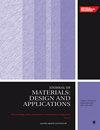Effect of Zr on static recrystallization of deformed austenite and strain-induced precipitation in Ti microalloyed steel
IF 2.2
4区 材料科学
Q3 MATERIALS SCIENCE, MULTIDISCIPLINARY
Proceedings of the Institution of Mechanical Engineers, Part L: Journal of Materials: Design and Applications
Pub Date : 2024-01-05
DOI:10.1177/14644207231224976
引用次数: 0
Abstract
The static recrystallization and strain-induced precipitation behavior of Ti and Ti-Zr low carbon microalloyed steels were studied through isothermal stress relaxation experiments at different deformation temperatures (875–1025 °C). The precipitation kinetic curves of microalloyed carbides were obtained, and the effect of Zr on the precipitation kinetics of microalloyed carbides was analyzed. Two static recrystallization kinetic models were established, and the activation energies for static recrystallization of Ti steel and Ti-Zr steel were calculated to be 312.44 and 246.59 kJ/mol, respectively. The results indicate that the addition of Zr lowers the nose point temperature of the precipitation–time–temperature curve, shortens the incubation period for the nucleation of precipitates, promotes the nucleation of strain-induced precipitates in Ti microalloyed steel, and reduces the coarsening rate of precipitates particles by an order of magnitude. In addition, the addition of Zr also advances the end time of static recrystallization of deformed austenite, inhibits the growth of static recrystallization austenite grains in Ti steel during the isothermal process, and makes the austenite grains finer and more uniform.Zr 对钛微合金钢中变形奥氏体静态再结晶和应变诱导析出的影响
在不同变形温度(875-1025 °C)下,通过等温应力松弛实验研究了 Ti 和 Ti-Zr 低碳微合金钢的静态再结晶和应变诱导析出行为。获得了微合金化碳化物的析出动力学曲线,并分析了 Zr 对微合金化碳化物析出动力学的影响。建立了两个静态再结晶动力学模型,计算出 Ti 钢和 Ti-Zr 钢的静态再结晶活化能分别为 312.44 和 246.59 kJ/mol。结果表明,Zr 的加入降低了析出时间-温度曲线的鼻点温度,缩短了析出物成核的潜伏期,促进了 Ti 微合金钢中应变诱导析出物的成核,并使析出物颗粒的粗化率降低了一个数量级。此外,添加 Zr 还能提前变形奥氏体静态再结晶的结束时间,抑制等温过程中 Ti 钢中静态再结晶奥氏体晶粒的生长,并使奥氏体晶粒更细、更均匀。
本文章由计算机程序翻译,如有差异,请以英文原文为准。
求助全文
约1分钟内获得全文
求助全文
来源期刊

CiteScore
4.70
自引率
8.30%
发文量
166
审稿时长
3 months
期刊介绍:
The Journal of Materials: Design and Applications covers the usage and design of materials for application in an engineering context. The materials covered include metals, ceramics, and composites, as well as engineering polymers.
"The Journal of Materials Design and Applications is dedicated to publishing papers of the highest quality, in a timely fashion, covering a variety of important areas in materials technology. The Journal''s publishers have a wealth of publishing expertise and ensure that authors are given exemplary service. Every attention is given to publishing the papers as quickly as possible. The Journal has an excellent international reputation, with a corresponding international Editorial Board from a large number of different materials areas and disciplines advising the Editor." Professor Bill Banks - University of Strathclyde, UK
This journal is a member of the Committee on Publication Ethics (COPE).
 求助内容:
求助内容: 应助结果提醒方式:
应助结果提醒方式:


